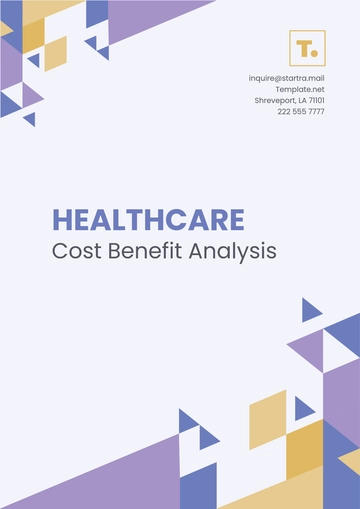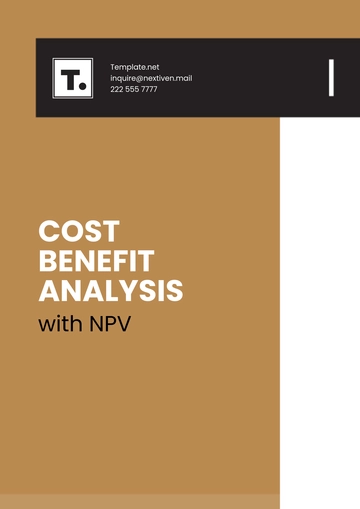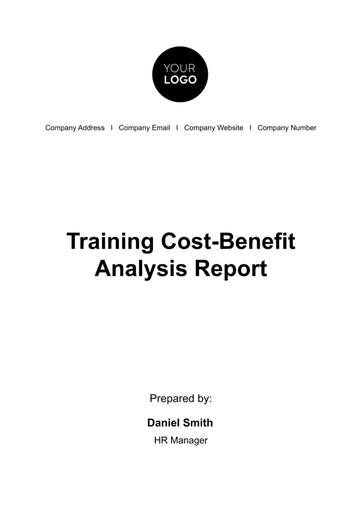Free Safety Financial Impact Analysis

I. Executive Summary
The Executive Summary encapsulates the core findings of the Safety Financial Impact Analysis for [Your Company Name], offering a concise yet comprehensive overview. [Your Company Name] recognizes the integral relationship between safety initiatives and financial outcomes. This analysis illuminates key insights into potential hazards, risks, and the strategic integration of safety measures.
Notably, the identified safety enhancements not only mitigate risks but also project substantial financial savings and heightened productivity. The Executive Summary serves as a strategic guide, emphasizing the symbiotic relationship between safety and financial success, propelling [Your Company Name] toward a future of excellence and resilience.
II. Introduction
A. Background
[Your Company Name] recognizes the importance of prioritizing safety to protect its workforce and assets. The purpose of this analysis is to evaluate the financial impact of proposed safety enhancements.
B. Objectives
Identify potential safety hazards.
Assess associated risks.
Analyze costs and benefits of safety measures.
Provide recommendations for implementation.
III. Safety Assessment
A. Hazard Identification
Chemical exposure in the production area.
Slips, trips, and falls in common areas.
Electrical hazards in manufacturing zones.
B. Risk Assessment
Chemical exposure:
High risk due to the nature of materials handled.
Slips, trips, and falls:
Moderate risk, with past incidents analyzed.
Electrical hazards:
Low risk, but preventive measures required.
Current Safety Measures
Personal protective equipment (PPE) requirements.
Regular safety training sessions.
Emergency response plans.
IV. Financial Assessment
A. Cost Analysis
1. Implementation Costs
Category | Estimated Cost |
PPE upgrades | [$10,000] |
Safety training programs | |
Chemical storage upgrades | |
Total |
2. Operating Costs
Category | Annual Cost |
Ongoing training | [$5,000] |
Maintenance services | |
Total |
B. Benefits Analysis
Accident Reduction
A conservative estimate suggests a [20]% reduction in accidents, saving an average of $[25,000] annually.
Insurance Premiums
Improved safety measures are expected to lead to a [50]% reduction in insurance premiums, saving $[50,000] annually.
Productivity and Morale
Improved safety is anticipated to enhance productivity, resulting in a conservative estimate of $[20,000] in additional revenue annually.
V. Cost-Benefit Analysis
Category | Annual Savings |
Accident Reduction | [$20,000] |
Insurance Premiums | |
Productivity and Morale | |
Total Annual Savings |
VI. Regulatory Compliance
A detailed review of safety regulations has been conducted to ensure that the proposed safety measures align seamlessly with current industry standards and statutory requirements. The analysis confirms that the recommended enhancements are in full compliance with regulations set forth by [relevant regulatory bodies, e.g., Occupational Safety and Health Administration (OSHA)]. Adhering to these standards not only ensures a safe working environment but also shields [Your Company Name] from potential legal and financial repercussions.
VII. Recommendations
Building upon the Safety Financial Impact Analysis, the following detailed recommendations are provided to fortify safety protocols and maximize financial benefits:
A. Immediate Implementation of Upgraded PPE Requirements
1. Rationale:
The high-risk nature of chemical exposure demands an urgent upgrade to personal protective equipment (PPE).
2. Action Steps:
A. Source and distribute enhanced PPE kits to all relevant personnel within the next [20] days.
B. Conduct mandatory training sessions on the proper use and maintenance of the upgraded PPE.
B. Enhanced Safety Training Programs for All Employees
1. Rationale:
A proactive approach to safety training will empower all employees to identify and mitigate risks, fostering a culture of safety throughout the organization.
2. Action Steps:
A. Collaborate with external safety training experts to design a comprehensive program tailored to the unique risks identified.
B. Implement a phased training schedule over the next [10] days, ensuring all employees receive specialized training relevant to their roles.
C. Priority Focus on Chemical Storage Upgrades
1. Rationale:
Mitigating the risks associated with chemical storage is critical to ensuring the safety of both personnel and assets.
2. Action Steps:
A. Engage with certified engineers and consultants to conduct a detailed assessment of current chemical storage facilities.
B. Implement recommended upgrades within the next [10] days, prioritizing enhancements to containment, labeling, and ventilation systems.
VIII. Implementation Plan
A. Timeline
Phase | Duration |
Phase 1 | [Months 1-3] |
Phase 2 | [Months 4-6] |
Phase 3 | Ongoing |
B. Budget Allocation
Phase | Budget Allocation |
Phase 1 | [$20,000] |
Phase 2 | |
Phase 3 | |
Contingency | |
Total Budget |
IX. Monitoring and Evaluation
To ensure the ongoing effectiveness of the implemented safety measures, a robust monitoring and evaluation framework will be established. Key performance indicators (KPIs) will be tracked at regular intervals, with quarterly assessments conducted to gauge the impact of the safety enhancements. The following metrics will be closely monitored:
A. Incident Reduction Rate
Measurement:
Quarterly comparison of reported incidents pre- and post-implementation.Objective:
Achieve a steady reduction in the number of safety incidents, aiming for a minimum [10]% decrease within the first year.
B. Employee Compliance with PPE Usage
Measurement:
Periodic audits and employee feedback.Objective:
Attain [20]% compliance with the proper and consistent use of upgraded PPE within the first three months.
C. Training Effectiveness
Measurement:
Post-training assessments and continuous feedback.Objective:
Ensure a minimum [20]% employee proficiency in understanding and implementing safety protocols acquired through training.
X. Conclusion
By implementing the recommended safety measures, we fortify our commitment to employee well-being, regulatory compliance, and financial prudence. This strategic approach, marked by phased enhancements and vigilant monitoring, ensures a resilient and productive workplace. As safety becomes ingrained in our culture, we anticipate a positive impact on both our bottom line and workforce morale. [Your Company Name] is not merely meeting standards; we are setting a benchmark for safety excellence that fosters sustainable growth, operational resilience, and employee satisfaction.
- 100% Customizable, free editor
- Access 1 Million+ Templates, photo’s & graphics
- Download or share as a template
- Click and replace photos, graphics, text, backgrounds
- Resize, crop, AI write & more
- Access advanced editor
Enhance safety planning with Template.net's Safety Financial Impact Analysis Template. This editable and customizable tool, powered by our Ai Editor Tool, helps you assess the financial implications of safety measures. Ensure cost-effective safety strategies and mitigate risks effectively. Empower your safety planning with Template.net's innovative solutions.





























